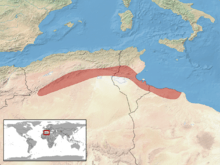Macrovipera deserti
| Macrovipera deserti | |
|---|---|
| Scientific classification | |
| Kingdom: | Animalia |
| Phylum: | Chordata |
| Class: | Reptilia |
| Order: | Squamata |
| Suborder: | Serpentes |
| Family: | Viperidae |
| Genus: | Macrovipera |
| Species: | M. deserti |
| Binomial name | |
| Macrovipera deserti (Anderson, 1892) | |
 | |
| Synonyms | |
Macrovipera deserti is a venomous viper species endemic to North Africa.[1] No subspecies are currently recognized.[6]
Description
It grows to a total length (body + tail) of 1.6 m (5.2 ft).[3] Others say 1.3 m (4.3 ft).[4]
Common names
Desert viper,[3][4] Libyan desert blunt-nosed viper,[5] desert adder,[7] Sahara adder, Sahara viper.[8]
Geographic range
It is found in North Africa in Libya, Tunisia, and possibly in Algeria.
The type locality given in the original description is "Duriat, South Tunisia".[1] Mallow et al. (2003) mention that it does occur in the southern foothills of the Atlas Mountains in Algeria.[4]
Conservation status
This species is classified as Near Threatened (NT) according to the IUCN Red List of Threatened Species (v3.1, 2001).[9] It is classified as such because its extent of occurrence is probably not much greater than 20,000 km² (7,722 sq mi) and its population is likely declining due to over-harvesting and persecution, therefore making the species close to qualifying for Vulnerable. The population trend is down. Year assessed: 2005.[10]
Habitat
Occurs in rocky, mountainous areas that are semiarid, but well-vegetated.[3]
Reproduction
This species lays eggs (oviparous).[3]
Venom
Little is known about its venom. Antivenoms meant for M. lebetina and Daboia russelii show the strongest cross-reactivity with this venom.[4]
See also
- List of viperine species and subspecies
- Viperinae by common name
- Viperinae by taxonomic synonyms
- Snakebite
References
- 1 2 3 McDiarmid RW, Campbell JA, Touré T. 1999. Snake Species of the World: A Taxonomic and Geographic Reference, Volume 1. Washington, District of Columbia: Herpetologists' League. 511 pp. ISBN 1-893777-00-6 (series). ISBN 1-893777-01-4 (volume).
- ↑ The Reptile Database. www.reptile-database.org.
- 1 2 3 4 5 Mallow D, Ludwig D, Nilson G. 2003. True Vipers: Natural History and Toxinology of Old World Vipers. Malabar, Florida: Krieger Publishing Company. 359 pp. ISBN 0-89464-877-2.
- 1 2 3 4 5 Spawls S, Branch B. 1995. The Dangerous Snakes of Africa. Dubai: Ralph Curtis Books. Oriental Press. 192 pp. ISBN 0-88359-029-8.
- 1 2 Mehrtens JM. 1987. Living Snakes of the World in Color. New York: Sterling Publishers. 480 pp. ISBN 0-8069-6460-X.
- ↑ "Macrovipera deserti". Integrated Taxonomic Information System. Retrieved 6 August 2006.
- ↑ Brown JH. 1973. Toxicology and Pharmacology of Venoms from Poisonous Snakes. Springfield, Illinois: Charles C. Thomas. 184 pp. LCCCN 73-229. ISBN 0-398-02808-7.
- ↑ U.S. Navy. 1991. Poisonous Snakes of the World. United States Government. New York: Dover Publications Inc. 203 pp. ISBN 0-486-26629-X.
- ↑ Daboia deserti at the IUCN Red List. Accessed 2 September 2007.
- ↑ 2001 Categories & Criteria (version 3.1) at the IUCN Red List. Accessed 2 September 2007.
Further reading
- Anderson J. 1892. On a small Collection of Mammals, Reptiles, and Batrachians from Barbary. Proc. Zool. Soc. London 1892: 3-24. (Vipera lebetina Var. nov. deserti, pp. 20–23 + Plate I., Figures 6-7).
- Boulenger GA. 1896. Catalogue of the Snakes in the British Museum (Natural History). Volume III. Containing the ... Viperidæ. London: Trustees of the British Museum (Natural History). (Taylor and Francis, printers). xiv + 727 pp. + Plates I.- XXV. (Vipera lebetina var. deserti, p. 489).
- Herrmann H-W, Joger U, Nilson G. 1992. Phylogeny and systematics of viperine snakes. III. resurrection of the genus Macrovipera Reuss, 1927, as suggested by biochemical evidence. Amphibia-Reptilia 13 (4): 375-392.
- Lenk P, Kalyabina S, Wink M, Joger U. 2001. Evolutionary Relationships among the True Vipers (Reptilia: Viperidae) Inferred from Mitochondrial DNA Sequences. Phylogenetics and Evolution 19 (1): 94-104. (Daboia deserti).
- Obst FJ. 1983. Zur Kenntnis der Schlangengattung Vipera. Zool. Abh. staatl. Mus. Tierkunde Dresden 38: 229-235.
External links
- Daboia deserti at the Reptarium.cz Reptile Database. Accessed 21 November 2013.
